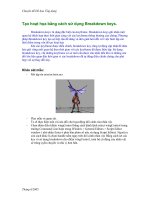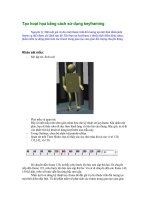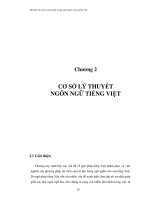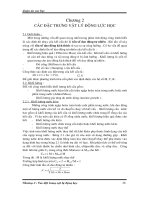03 controlstructures key
Bạn đang xem bản rút gọn của tài liệu. Xem và tải ngay bản đầy đủ của tài liệu tại đây (1.41 MB, 36 trang )
Hochiminh University of Technology
Computer Science and Engineering - [CO1011 - 501127]
Fundamentals of
C++ Programming
Control Structures
(part 1)
Lecturer: Duc Dung Nguyen
Credits: 4
Outcomes
❖
Understand basic control structures in C/C++
❖
if-else statement
❖
switch statement
❖
Solve the problem using conditional executions
❖
Implement if-else, switch-case statements
2
Today’s outline
❖
Conditional execution
❖
if-else statement
❖
❖
Nested conditionals
switch statement
❖
Enum type
3
Conditional execution
Conditional execution
❖
Boolean expression: evaluate to true/false
❖
What is true? What is false?
❖
bool type
❖
Type conversion
❖
Assignment
❖
Common expressions
5
Conditional execution
❖
❖
Type bool: true/false
❖
Size: 1 byte (basic unit of storage)
❖
Be represented as integer: true = 1, false = 0
What happens when you assign a value to boolean type:
❖
False: 0 value (for integer, floating point number, character ‘\0’)
❖
True: anything else (except structures, unless a casting operator is defined)
6
Conditional execution
❖
Relational operators
Operator
Meaning
“=="
Equal to
“<"
Less than
“>"
Greater than
“<="
Less than or equal to
“>="
Greater than or equal to
“!=”
Not equal to
7
Conditional execution
❖
Logic operators
Operator
Meaning
!
not
&&
and
||
or
8
Conditional execution
❖
Examples:
❖
bool b = true, b1 = false;
int a = -1, c = 0;
float x = 0.5f, y = 1.2f;
b = a > c;
b1 = a;
b = c;
b1 = x < y && a > c;
b = x;
c = y + b1;
b1 = 50 != ‘a’;
b = x + 4.9 < y / 0.5f;
9
If-else statement
If-else statement
❖
❖
Simple if statement:
❖
Execute a statement or a list of statements if the given condition is satisfied
❖
if (<conditional expression>) <statement>;
❖
if (<conditional expression>) {
<statements>
}
E.g.:
❖
if (a > b)
cout << a << “ is greater than ” << b << endl;
11
If-else statement
❖
Flowchart
simple if statement
<exp>
Y
statement
statement
12
N
If-else statement
❖
Example:
#include <iostream>
int main() {
float a, b, c, delta;
cout << “Please input three real values a, b, c: ”;
cin >> a >> b >> c;
delta = b * b - 4 * a * c;
if (delta < 0)
cout << "Have no real root" << endl;
return 0;
}
#include <iostream>
int main() {
float a, b, c, delta;
cout << “Please input three real values a, b, c: ”;
cin >> a >> b >> c;
delta = b * b - 4 * a * c;
if (delta < 0);
return 0;
}
13
If-else statement
❖
Examples
#include <iostream>
#include <iostream>
int main() {
float a, b, c, delta;
cout << “Input three real values a, b, c: ”;
cin >> a >> b >> c;
delta = b * b - 4 * a * c;
if (delta < 0) {
cout << “Delta value is negative” << endl;
cout << "Have no real root" << endl;
}
return 0;
}
int main() {
float a, b, c, delta;
cout << “Input three real values a, b, c: ”;
cin >> a >> b >> c;
delta = b * b - 4 * a * c;
if (delta < 0)
cout << “Delta value is negative” << endl;
cout << "Have no real root" << endl;
14
}
return 0;
If-else statement
❖
Full if-else statement:
❖
if (<conditional expression>) <if-true statement>;
else <if-false statement>;
❖
if (<conditional expression>) {
<if-true statements>
}
else {
<if-false statements>
}
15
If-else statement
❖
Flowchart
full if-else statement
<exp>
N
Y
if-true
statement
if-false
statement
statement
16
If-else statement
❖
Examples
#include <iostream>
int main() {
float a, b, c, delta;
cout << “Input three real values a, b, c: ”;
cin >> a >> b >> c;
delta = b * b - 4 * a * c;
if (delta < 0) {
cout << “Delta value is negative” << endl;
cout << "Have no real root" << endl;
}
else cout << “The quadratic equation has at least one root” << endl;
return 0;
}
17
Nested conditionals
❖
Nested if-else statements
❖
if (<exp>)
// first check
if (<exp>)
// second check
if (<exp>)
// third check
<statement>
else <statement>
else <statement>
else if (<exp>) <statement>
else if (<exp>) <statement>
else <statement>
18
Nested conditionals
❖
Nested if-else statements: multi-way
❖
if (<exp 1>) <statement 1>
else if (<exp 2>) <statement 2>
else if (<exp 3>) <statement 3>
else <statement 4>
❖
if (<exp 1>) <statement 1>
else if (<exp 2>) <statement 2>
else if (<exp 3>) <statement 3>
else <statement 4>
19
Switch statement
Switch statement
❖
A convenient way to write multi-way statement
❖
switch(<exp>) {
case <value 1>: <statements>;
case <value 2>: <statements>;
…
case <value N>: <statements>;
default: <statements>;
}
21
Switch statement
❖
Flowchart
<case1>
Y
case 1
statements
N
<case2>
N
<case3>
N
Y
Y
case 2
statements
case 3
statements
statement
22
defaults
Switch statement
❖
A convenient way to write multi-way statement
❖
switch(<exp>) {
case <value 1>: <statements>; break;
case <value 2>: <statements>; break;
…
case <value N>: <statements>; break;
default: <statements>;
}
23
Switch statement
❖
Example:
#include <iostream>
int main() {
// Do something
int usrChoice;
cout << “Please make your choice (1~4): ”;
cin >> usrChoice;
if (usrChoice < 1 || usrChoice > 4)
cout << “Cannot recognise your choice” << endl;
else switch (usrChoice) {
case 1:
cout << “pick 1” << endl;
cout << “action 1” <
cout << “pick 2” << endl;
cout << “action 2” << endl;
case 3:
cout << “pick 3” << endl;
cout << “action 3” <
cout << “pick 4” << endl;
cout << “action 4” << endl;
}
return 0;
}
#include <iostream>
int main() {
// Do something
int usrChoice;
cout << “Please make your choice (1~4): ”;
cin >> usrChoice;
switch (usrChoice) {
case 1:
cout << “pick 1” << endl;
cout << “action 1” <
cout << “pick 2” << endl;
cout << “action 2” << endl; break;
case 3:
cout << “pick 3” << endl;
cout << “action 3” <
cout << “pick 4” << endl;
cout << “action 4” << endl; break;
default:
cout << “Cannot recognise your choice” << endl;
}
return 0;
}
24
Enumerated type
❖
❖
Define a list of possible values of a type
❖
enum <type name> {<name of possible values>};
❖
enum [<type name>] {<name of possible values>} <variables>;
Example:
❖
enum Color {Red, Orange, Yellow, Green, Blue, Violet};
Color c = Yellow;
out << “Yellow color has value: ” << c << endl;
25







